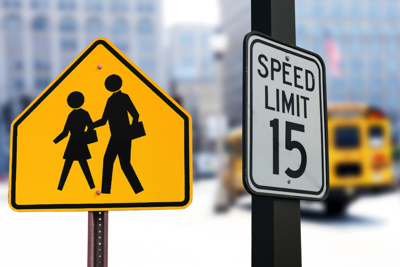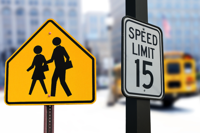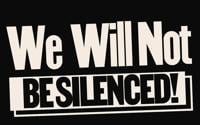
On Wednesday, the Los Angeles City Council authorized new 15 mph speed limits on 343 streets surrounding 201 schools.
In a unanimous vote, council members approved a resolution instructing the Department of Transportation to install signs to limit vehicular speed at pre-designated areas. Officials anticipate the project will be complete within six to 10 weeks using Measure M local return funds for work and overtime costs, which are estimated at $750,000.
Councilwoman Heather Hutt, chair of the Transportation Committee, has led an effort to enhance safety for students and families getting to and from schools. Councilwoman Eunisses Hernandez, who supported the proposal, described it as an "urgent and necessary step."
"Traffic collisions are the leading cause of death for youth ages two to 14, and nearly 56% of fatal and serious injury crashes ... happen within a quarter mile of a school," Hernandez said.
According to the LADOT 2021-2023 Strategic Plan, 41% of traffic collision victims are Latinos.
Some of the schools approved for the 15 mph speed zones include Alliance College-ready Middle School Academy 5, Los Angeles Leadership Primary Academy, Figueroa Elementary School, USC Hybrid High School and more public and private schools throughout Highland Park, Lincoln Heights, South L.A., Sylmar, Panorama City, Pacoima, Wilmington and more.
The councilwoman noted funding for speed humps decreased from $1.9 million in previous years to $715,000 for the current fiscal year, limiting the number of installations to about 120 citywide.
Elected officials allocated a total of $216.6 million to the Department of Transportation in the 2024-25 fiscal year, a decrease of $323,538 from the 2023-24 fiscal year.
The department's speed hump program received roughly $715,000, and the speed hump and speed table program for schools received $303,161 of the city's general fund, according to figures from the adopted budget in the 2024- 25 fiscal year.
School safety zones can be designated much sooner, she added.
Of the 201 schools set to benefit from the new schools safety zones, nine are in Hernandez's First District, encompassing northeast Los Angeles neighborhoods.
"Let's direct LADOT to move forward and help make our streets safer for our young people in a more cost-effective way with these school safety zones," she added.
Under California code, a local authority can by ordinance or resolution set a speed limit near a school that is lower than the speed limit in the surrounding neighborhood.
While the school zone speed limit is 25 mph, the state's regulations allow for 15 mph school zones on streets that meet specific criteria, according to the Department of Transportation. The reduced speed limit only applies while children are attending or leaving school.
The city's efforts are being guided by the DOT's Safe Routes to School Strategic Plan, which was introduced in 2012 to implement data-driven processes and improve safety around campuses. Department staff and Los Angeles Unified School District officials developed a methodology to identify schools in need.
In 2016, city officials established 15 mph school zone speed limits at 11 of the top 50 LAUSD schools in critical need of such safety treatments. By August 2023, another 98 street segments adjacent to 44 schools, including some of the remaining top 50 schools, were provided with updated school zone speed limits.
Several of the streets are found on the city's High Injury Network, which identifies corridors with a high concentration of collisions that result in severe injuries and deaths, as well those involving pedestrians and cyclists.
Damian Kevitt, executive director of Streets Are For Everyone, told City News Service previously that the city's plan sets appropriate speeds for school zones and are in alignment with most European countries, where he said roads are much safer.
He described the city's efforts as a good gesture, but criticized elected officials for doing so without also increasing speed enforcement strategies.
In early 2024, SAFE released a report on the city's traffic safety strategies, giving them an F grade. A recent independent audit of L.A.'s Vision Zero, a strategy to eliminate all traffic fatalities and severe injuries by 2025, found that it failed to reduce such dangers.
Former Mayor Eric Garcetti implemented the Vision Zero plan in 2015, but during the first two years there were a total of 245 and 241 traffic- related deaths involving drivers, bicyclists and pedestrians. In 2022 and 2023, there were 368 and 333 traffic-related deaths, respectively. According to preliminary data, those figures stood at more than 300 for 2024.
Under Vision Zero, the city attempted to implement so-called "road diets" in some areas -- reducing traffic lanes on some streets in favor of dedicated bike and pedestrian corridors -- but such efforts were met with anger by motorists suddenly stuck in slow traffic. The outcry was so great that the city removed the traffic-calming measures in Playa Vista.
"Reducing school zone speed limits is a good gesture and necessary, but there is so much more the city could and should be doing to save lives on our roads," Kevitt previously said in an email.
Additional reporting by City News Service.











(0) comments
Welcome to the discussion.
Log In
Keep it Clean. Please avoid obscene, vulgar, lewd, racist or sexually-oriented language.
PLEASE TURN OFF YOUR CAPS LOCK.
Don't Threaten. Threats of harming another person will not be tolerated.
Be Truthful. Don't knowingly lie about anyone or anything.
Be Nice. No racism, sexism or any sort of -ism that is degrading to another person.
Be Proactive. Use the 'Report' link on each comment to let us know of abusive posts.
Share with Us. We'd love to hear eyewitness accounts, the history behind an article.